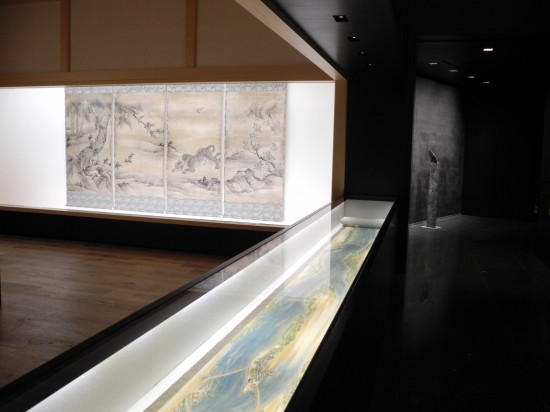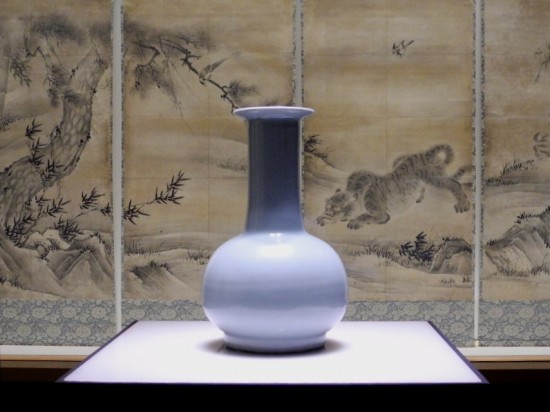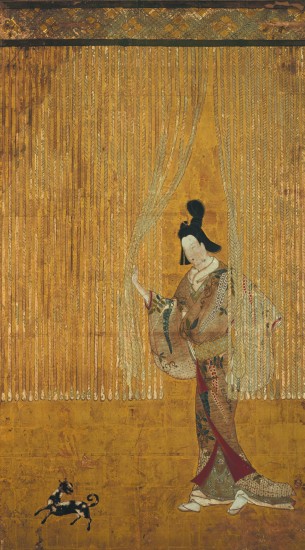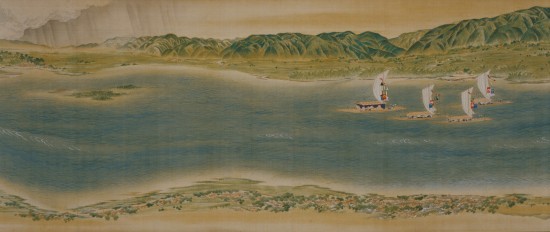from Hara Museum ARC (Gunma)
Part I of Masterpieces from the Hara Rokuro Collection at the Kankai Pavilion closed on October 9 (Wednesday). Part II opened on October 11 (Friday).

Exhibition scene from Part I
The following works comprise the three centerpieces of Part II: the National Treasure Celadon vase with long neck on globular body, one of the collection’s most representative pieces; the Important Cultural Property Female passing through a reed portiere; and Maruyama Okyo’s Landscape of Yodo River. They appear together for the first time since the Gotemyama Hara Collection exhibition at the MOA Museum of Art in 2001.

Celadon vase with long neck on globular body (National Treasure), Southern Song dynasty, China
Considered a masterpiece among the celadon vases that have come to Japan from China, this piece derives its captivating beauty from its pale blue glaze, smooth surface and soft roundness. Look closely at the fine texture of the glaze and notice the almost total absence of cracks.

Female passing through a reed portiere (Important Cultural Asset), two-fold screen, Edo period
This picture shows a dog being followed by a beautiful woman emerging from behind a reed curtain. The red nails on her hands and feet identify her as a courtesan. The bamboo blind, which was added later, is used to evoke the image of the Heian court and the scene of Kashiwagi and Onna San no Miya from Wakana, Chapter 34 of The Tale of Genji. The woman’s appearance gives us an idea of what was fashionable at the time; for example, the so-called “tateryogo” hairdo and the “naginata” sleeves and embroidery. Stylistically, this painting is an important example from the transition period that preceded the emergence of the bijinzu, pictures dominated by a single standing female figure.

Landscape of Yodo River (detail), Maruyama Okyo, Edo period
On display is the middle portion of the 16-meter long scroll painting of sites along the Yodo River. Here, six boats that have disembarked from Fushimi in Kyoto to Tenmabashi are seen passing Mt. Otokoyama, on which is drawn the pagoda of Iwashimizu Hachimangu Temple, followed by Mt. Tennozan. Of interest is how Okyo captures the color of the sky, the clouds and the weather conditions as they change with the passage of time.
We invite you to come enjoy this beautiful assembly of masterpieces from the Hara Rokuro Collection.
[Featured works]
Traditional art: Celadon vase with long neck on globular body (National Treasure), Southern Song dynasty / Landscape of Yodo River, Maruyama Okyo, hand scroll, Edo period / Reisho′nyo, a female wizard with flower basket, attributed Jasoku, hanging scroll, Muromachi period / Female passing through a reed portiere, two-fold screen, Edo period / Avalokitesyara appearing from the clam, Kano Tan’yu, hanging scroll, Edo period
Contemporary art: Anish Kapoor, Void, 1992 / Isamu Noguchi, Lady Mirror, 1983 / Hiroshi Sugimoto, Seascape series, 1990-1991 / Noe Aoki, tateyama, 2007 and others
